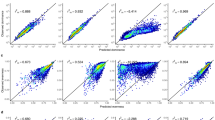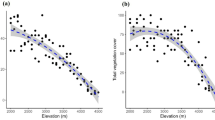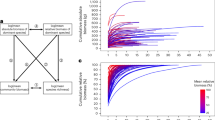Abstract
The universal observation that some species in an ecological community are common, but many more are rare, is neatly encapsulated in a species abundance distribution (SAD)1. However, the shape of the distribution can depend on the currency used to measure abundance 2. Here we show how the SADs for numerical abundance and biomass are related and how this relationship can be used to predict the form of the SAD. When plotted in log numerical abundance, log biomass space, species points lie within an approximately triangular area the limits of which are set by body size range, and the upper limit of abundance in both metrics. Under the simplifying, but reasonable, assumption that the observed scatter of species within this region is random, the shape of the SAD is immediately derived from simple geometrical considerations. For the SAD of numerical abundance this is a power curve. The biomass SAD can be either a power curve or, more frequently, a unimodal curve, which can approximate a log normal. This log triangular random placement model serves as a null hypothesis against which actual communities can be compared. Data from two intensively surveyed local communities indicate that it can give a good approximation, with species scattered within a triangle. Further, we can predict the consequences, for the SAD, of size-selective sampling protocols. We argue that mechanistic models of SADs must be able to account for the relative abundance of species in alternative currencies. Moreover, this approach will shed light on niche packing and may have application in environmental monitoring.
Similar content being viewed by others
Article PDF
Author information
Authors and Affiliations
Corresponding author
Rights and permissions
About this article
Cite this article
Henderson, P., Magurran, A. Predicting species abundance distributions by simultaneously using number and biomass as units of measurement. Nat Prec (2007). https://doi.org/10.1038/npre.2007.1405.1
Received:
Accepted:
Published:
DOI: https://doi.org/10.1038/npre.2007.1405.1



